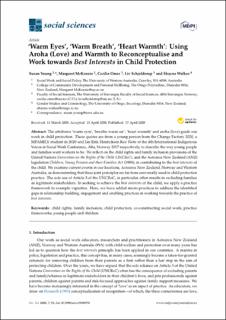| dc.contributor.author | Young, Susan | |
| dc.contributor.author | McKenzie, Margaret | |
| dc.contributor.author | Omre, Unn Cecilie | |
| dc.contributor.author | Schjelderup, Liv | |
| dc.contributor.author | Walker, Shayne | |
| dc.date.accessioned | 2021-02-22T14:16:28Z | |
| dc.date.available | 2021-02-22T14:16:28Z | |
| dc.date.created | 2020-10-06T13:17:22Z | |
| dc.date.issued | 2020-04 | |
| dc.identifier.citation | Young, S., McKenzie, M., Omre, C. et al. (2020) ‘Warm Eyes’, ‘Warm Breath’, ‘Heart Warmth’: Using Aroha (Love) and Warmth to Reconceptualise and Work towards Best Interests in Child Protection. Social Sciences, 9 (4), https://doi.org/10.3390/socsci9040054. | en_US |
| dc.identifier.issn | 2076-0760 | |
| dc.identifier.uri | https://hdl.handle.net/11250/2729574 | |
| dc.description.abstract | The attributes ‘warm eyes’, ‘breathe warm air’, ‘heart warmth’ and aroha (love) guide our work in child protection. These quotes are from a young person from the Change Factory 2020, a MFAMILY student in 2020 and Jan Erik Henricksen Key Note at the 4th International Indigenous Voices in Social Work Conference, Alta, Norway 2017 respectively, to describe the way young people and families want workers to be. We reflect on the child rights and family inclusion provisions of the United Nations Convention on the Rights of the Child (UNCRoC), and the Aotearoa New Zealand (ANZ) legislation Children, Young Persons and their Families Act (1989), in contributing to the best interests of the child. We examine current events in our locations, Aotearoa New Zealand, Norway and Western Australia, as demonstrating that these joint principles are far from universally used in child protection practice. The sole use of Article 3 of the UNCRoC, in particular, often results in excluding families as legitimate stakeholders. In seeking to achieve the best interests of the child, we apply a practice framework to example vignettes. Here, we have added micro-practices to address the identified gaps in relationship building, engagement and enabling practices in working towards the practice of best interests. | en_US |
| dc.language.iso | eng | en_US |
| dc.publisher | MDPI | en_US |
| dc.rights | Navngivelse 4.0 Internasjonal | * |
| dc.rights.uri | http://creativecommons.org/licenses/by/4.0/deed.no | * |
| dc.subject | barnevern | en_US |
| dc.subject | sosialt arbeid | en_US |
| dc.subject | barns rettigheter | en_US |
| dc.title | ‘Warm Eyes’, ‘Warm Breath’, ‘Heart Warmth’: Using Aroha (Love) and Warmth to Reconceptualise and Work towards Best Interests in Child Protection | en_US |
| dc.type | Peer reviewed | en_US |
| dc.type | Journal article | en_US |
| dc.description.version | publishedVersion | en_US |
| dc.rights.holder | © 2020 by the authors. | en_US |
| dc.subject.nsi | VDP::Samfunnsvitenskap: 200::Sosialt arbeid: 360 | en_US |
| dc.source.pagenumber | 20 | en_US |
| dc.source.volume | 9 | en_US |
| dc.source.journal | Social Sciences | en_US |
| dc.source.issue | 4 | en_US |
| dc.identifier.doi | 10.3390/socsci9040054 | |
| dc.identifier.cristin | 1837606 | |
| dc.source.articlenumber | 54 | en_US |
| cristin.ispublished | true | |
| cristin.fulltext | original | |
| cristin.qualitycode | 1 | |

